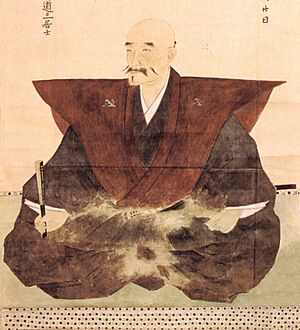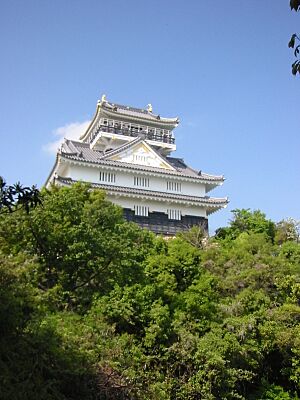Saitō Dōsan facts for kids
Quick facts for kids
Saitō Dōsan
|
|
|---|---|
| 斎藤道三 | |
 |
|
| Head of Saitō clan | |
| In office 1542–1556 |
|
| Succeeded by | Saitō Yoshitatsu |
| Lord of Mino | |
| In office 1542–1556 |
|
| Preceded by | Toki Yorinari |
| Succeeded by | Saito Yoshitatsu |
| Personal details | |
| Born | 1494 |
| Died | May 28, 1556 (aged 61–62) Battle of Nagaragawa, Mino Province |
| Relations | Oda Nobunaga (son in law) Akechi Mitsutsuna (brother in law) |
| Children | Saitō Yoshitatsu Nōhime |
| Nickname | "Viper of Mino" |
| Military service | |
| Allegiance | |
| Rank | Daimyo |
| Unit | |
| Commands | Inabayama Castle |
| Battles/wars | Mino Campaign (1542) Battle of Kanōguchi (1547) Battle of Nagara-gawa (1556) † |
Saitō Dōsan (斎藤 道三, 1494 – May 28, 1556), also known as Saitō Toshimasa (斎藤 利政), was a Japanese samurai who lived during the Sengoku period. This was a time in Japan when many powerful lords fought for control.
Saitō Dōsan was also known as the "Viper of Mino" (美濃の蝮, Mino no Mamushi). He earned this nickname because he was very clever and sometimes ruthless in his plans. He held the special title of Yamashiro-no-kami from the Imperial Court. Later in his life, he became a monk and was called Saitō Yamashiro-nyudō-no-kami.
Contents
Becoming a Powerful Leader
Saitō Dōsan started his life as a monk, and then he became a seller of oil. He was very ambitious and managed to become a daimyō, which means a powerful feudal lord. He did this through a process called gekokujō, where a person of lower rank takes power from someone higher up.
In 1542, Dōsan took control of Mino Province from its previous ruler, Toki Yorinari. Yorinari was forced to leave Mino. Dōsan's main fortress was Inabayama Castle. He married a woman named Omi no Kata, who was the sister of Akechi Mitsutsuna.
Battles and Alliances
Saitō Dōsan was a skilled fighter. In 1547, he defeated Oda Nobuhide at the Battle of Kanōguchi.
However, in 1549, Dōsan and Oda Nobuhide decided to make peace. To seal this peace, they arranged a political marriage. Nobuhide's son and future leader, Oda Nobunaga, married Dōsan's daughter, Nōhime. This made Dōsan the father-in-law of Nobunaga. Dōsan supported this marriage, which helped Nobuhide focus on fighting another powerful lord, Imagawa Yoshimoto.
Family Conflict and Death
Several years later, problems arose within Dōsan's own family. There were rumors that his oldest son, Saitō Yoshitatsu, was not his biological son. Dōsan began to think about making another son, Saitō Kiheiji, or even his son-in-law, Oda Nobunaga, his heir instead.
This made Yoshitatsu very angry. He rebelled against his father and killed his two younger brothers. In 1556, Dōsan's forces fought against Yoshitatsu's army in the Battle of Nagara-gawa. Saitō Dōsan was killed in this battle.
After his death, Dōsan's head was taken by a man named Komaki Genta. Dōsan's body was first buried at Sōfuku-ji temple. Later, his remains were moved to Jōzai-ji because the Nagara River often flooded his burial site. Both temples are in the city of Gifu, which still celebrates Dōsan with a festival every year.
Many Names
Saitō Dōsan was known for having many different names throughout his life. Some people believe this is because there were actually two Saitō Dōsans, a father and a son. They think the son took his father's name after he died.
Some of his other names included Minemaru, Hōrenbō, Matsunami Shogorō, Nishimura Kankurō Masatoshi, Shinkurō, Nagai Norihide, and Saitō Sakondayu Toshimasa. He adopted the name Saitō from a powerful family that the Nagai clan had defeated in the 1520s.
Family Members
- Father: Matsuda Motomune (some stories say he was the child of Shinzaemonzo, a monk)
- Wife: Omi no Kata, daughter of Akechi Mitsutsugu
- Concubine: Miyoshi no Kata
- Children:
- Saitō Yoshitatsu (born to Miyoshi no Kata)
- Saitō Magoshirō
- Saitō Kiheiji
- Saitō Toshitaka
- Saitō Nagatatsu (Toshiharu)
- Nōhime (also known as Kicho)
See also
- Saitō clan
- Kunitori Monogatari (a story about his life)


